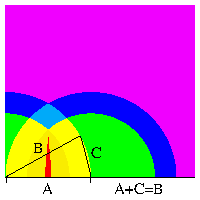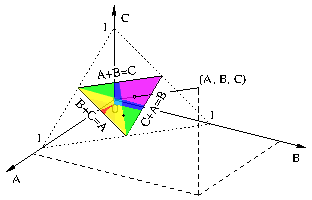Asymmetrical top
The asymmetrical or asymmetrical top is in the top theory a top with three different main moments of inertia .
For the general case of the asymmetrical heavy gyroscope , no solution to Euler's gyro equations was found at the beginning of the 21st century . Since there are only a few solutions and only for special cases, the analytical description is missing for the vast majority of gyroscopes. Current research deals, among other things, with the elaboration of invariant properties of the dynamic system.
Designations
A symmetrical top is said to be flattened if its axial torque is greater than its equatorial, and if the opposite is the case, it is called elongated. Similar terms are used for the asymmetrical top. If A, B and C are the main moments of inertia around the first, second and third main axis of inertia and A> B> C, then the gyro is
- short -axis with respect to the 1-axis (corresponding to a flattened symmetrical top),
- central axis with respect to the 2-axis and
- long -axis with respect to the 3-axis (corresponding to an elongated symmetrical top).
Main moments of inertia
The asymmetrical top has three different main moments of inertia A, B and C. With a rigid body , they satisfy the triangle inequalities
- A + B> C, B + C> A and A + C> B
see moment of inertia . Then there can be an asymmetrical top with the main moments of inertia A, B and C.
One of these moments of inertia can be used to scale the energy or the time in such a way that the relevant moment of inertia is equal to one in the physical laws under consideration , especially Euler's gyroscopic equations . Therefore, two gyros, in which the ratio of two of their main moments of inertia to the third is the same, have comparable rotational inertia properties. This allows the possible parameter combinations {A, B, C} to be reduced by one dimension to {α, β} = {B / A, C / A}. The restrictions apply to these dimensionless parameters
- α + 1> β, α + β> 1 and 1 + β> α.
Representation of the gyro types
The pictures show display options for gyro types. The parameter space is colored according to the seven areas found by Katok and Richter, in which the energy surface of the top has comparable topological properties. The Kowalewskaja gyroscope , where α = 1 and β = 1/2, is entered as a triangle (a) or as a point (b, c). The gyro types are illustrated in the pictures as follows:
- a) As a triangle
- Because the main moments of inertia satisfy the triangle inequalities, a top with main moments of inertia A, B and C can be represented by a triangle with corresponding side lengths. With side A held down, the opposite corner is in the upper half-plane. An asymmetrical top corresponds to an irregular triangle and the drawn symmetrical Kovalevskaya top corresponds to an isosceles triangle . A spherical top with three equal main moments of inertia corresponds to an equilateral triangle .
- b) As a point in the α-β plane
- A top with the dimensionless ratios α = B / A and β = C / A corresponds to a point in the α-β plane. The strip between α + 1 = β and β + 1 = α extends to the top right to infinity. The symmetrical tops lie on the straight line α = β, α = 1 or β = 1 and the spherical top lies at point (1, 1).
- c) As a point in the shape triangle
- In the space in which the main moments of inertia are plotted on the coordinate axes, the shape triangle has the corners at points (½, ½, 0), (½, 0, ½) and (0, ½, ½) and is shown in color in the picture . In this coordinate system, a given top corresponds to a point P = (A, B, C) and related top with similar rotational inertia properties lie on the straight line through the origin 0 and P. The point of intersection of this straight line through the plane A + B + C = 1 lies in the so-called shape triangle. It is the only one of the representations shown that includes all gyroscopes and yet only has a finite extent. The symmetrical tops lie on a bisector and the spherical top lies in the center of gravity (1/3, 1/3, 1/3).
Pseudoregular precession
The general asymmetrical top can only perform the Staude rotation evenly. A pseudo-regular precession, i.e. H. a movement that cannot be distinguished from a regular precession with the eye can be carried out by the asymmetrical top when it rotates rapidly around a main axis of inertia whose main moment of inertia A is the largest or the smallest main moment of inertia. The resulting precession is on average the same as the pseudoregular precession of a Lagrange top with the same axial moment of inertia A and the same support point moment, see main article. This precession is accompanied by four nutations in the form of epicycles , which were used to explain the planetary orbits well into the 17th century.
See also
- Heavy top : top in the gravitational field of the earth.
- Symmetrical top : top with two identical main moments of inertia.
- Dschanibekow effect : special movement of a force-free asymmetrical top.
Forms of motion of asymmetrical heavy gyroscopes:
Web links
Individual evidence
- ↑ a b Magnus (1971), p. 20.
- ↑ Gashenenko and Richter (2004), p. 2527.
- ↑ Gashenenko and Richter (2004), p. 2526.
- ↑ Magnus (1971), p. 21 f.
- ↑ Gashenenko and Richter (2004), p. 2542.
literature
- K. Magnus : Kreisel: Theory and Applications . Springer, 1971, ISBN 978-3-642-52163-8 , pp. 20 ( limited preview in Google Book Search [accessed February 20, 2018]).
-
R. Grammel : The top . Its theory and its applications. Vieweg Verlag, Braunschweig 1920, DNB 451641280 , p. 39 ( archive.org - "swing" means angular momentum, "rotary shock" means torque and "torsional balance" means rotational energy). or R. Grammel : The top . Theory of the gyro. 2. revised Edition volume
1 .. Springer, Berlin, Göttingen, Heidelberg 1950, DNB 451641299 , p. 121 ff . - F. Klein , A. Sommerfeld : Theory of the gyro . The technical applications of the gyro theory. Book IV. Teubner, Leipzig 1910, p. 767 ( archive.org [accessed October 21, 2017]).
- IG Gashenenko, PH Richter : Enveloping Surfaces And Admissible Velocities Of Heavy Rigid Bodies . In: World Scientific Publishing Company (Ed.): International Journal of Bifurcation and Chaos . tape 14 , no. 8 , 2004, ISSN 0218-1274 , p. 2525–2553 , doi : 10.1142 / S021812740401103X ( iamm.su [PDF; accessed June 2, 2019]).


